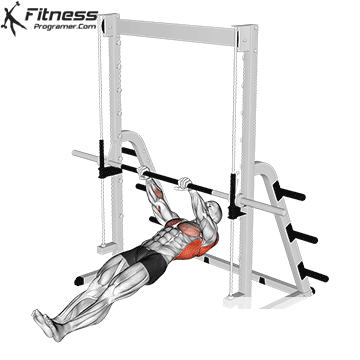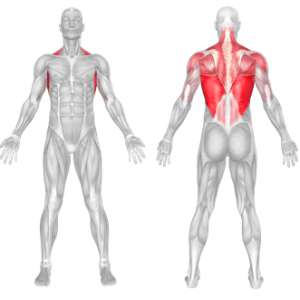Inverted Row Overview
The inverted row, also known as a bodyweight row, involves pulling your chest toward a horizontal bar while keeping your body straight. It’s performed in a reclined position, which reduces the resistance compared to pull-ups, making it an ideal choice for beginners or those looking for an easier pulling exercise.
How to Perform the Inverted Row:

Setup
- Find a Bar or Suspension Trainer
- Use a low bar on a squat rack, a Smith machine, or suspension straps (e.g., TRX). Ensure the equipment is sturdy.
- Adjust the Height
- Position the bar or straps at waist level or slightly lower. The lower the bar, the harder the exercise.
Execution
- Starting Position
- Lie underneath the bar with your chest aligned directly below it.
- Grab the bar with an overhand or underhand grip, hands shoulder-width apart.
- Extend your legs straight with your heels on the ground, keeping your body in a straight line from head to heels.
- Pull Up
- Engage your back and core, then pull your chest toward the bar by bending your elbows.
- Keep your elbows close to your body, and squeeze your shoulder blades together at the top.
- Lower Down
- Slowly extend your arms to return to the starting position, maintaining a straight body.
- Repeat
- Perform 8–12 repetitions for 3–4 sets, focusing on controlled movement.
Tips for Proper Form
- Engage the Core: Keep your abs tight to prevent your hips from sagging.
- Neutral Spine: Maintain a straight line from your head to your heels throughout the movement.
- Controlled Movement: Avoid jerking or using momentum; focus on slow, deliberate reps.
- Elbow Position: Keep your elbows close to your torso to avoid excessive strain on the shoulders.
- Bar Alignment: The bar should touch your chest or come close to it at the top of the movement.
Common Mistakes
- Sagging Hips: Letting your hips drop reduces core engagement and compromises form.
- Incomplete Range of Motion: Not pulling your chest close to the bar limits muscle activation.
- Flaring Elbows: Allowing your elbows to flare can strain your shoulders.
- Arching the Lower Back. Maintain a neutral spine by engaging your core and glutes.
Benefits of the Inverted Row
- Strengthens the Upper Back
- Targets key muscles in the upper back for improved pulling power and posture.
- Improves Posture
- Strengthens postural muscles, counteracting the effects of prolonged sitting or slouching.
- Core Engagement
- The need to maintain a straight body position activates and strengthens the core.
- Beginner-Friendly
- Provides a scalable alternative to pull-ups, making it accessible to all fitness levels.
- Joint-Friendly
- Places less strain on the shoulders and wrists compared to other pulling exercises.
Muscles Worked

